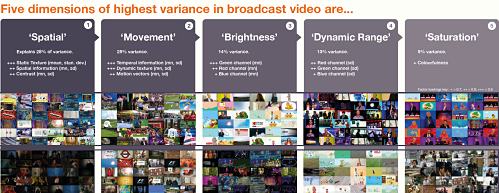What’s really on TV?

In order to evaluate the performance of new video technologies, we need to understand and represent the full breadth of consumer video content.
The parameterisation of video databases using low-level features has proven to be an effective way of quantifying the level of diversity within a database of video sequences. However, without a comprehensive understanding of the relative frequency of these features in the content people actually consume, the utility of such information is limited.
BVI researchers, Felix Mercer Moss, Roland Baddeley, Aaron Zhang and David Bull, in collaboration with BBC R&D, undertook a large-scale analysis of one year of programming on BBC One and CBeebies, the most popular television channels in the United Kingdom for adults and children, respectively. Relevant video features were extracted from almost three thousand television programmes shown throughout 2015 before principal component analysis was used to identify just five factors representing the most variation. The meaning and relative significance of these five factors, together with the shape of their frequency distributions, represent highly valuable information for researchers wanting to model the diversity of modern consumer content in representative video databases.

